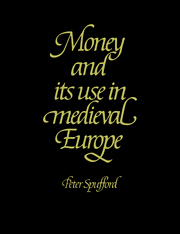Book contents
- Frontmatter
- Contents
- List of maps
- List of tables
- List of graphs
- Acknowledgements
- Introduction
- Part I Before the Commercial Revolution
- Part II The Commercial Revolution of the Thirteenth Century
- Part III The Late Middle Ages
- Conclusion
- Appendix I The Coins Most Commonly in Use in the Middle Ages
- Appendix II Money of Account
- Appendix III Production at Some Later Medieval Mints
- Bibliography
- Coin Index
- General Index
- Frontmatter
- Contents
- List of maps
- List of tables
- List of graphs
- Acknowledgements
- Introduction
- Part I Before the Commercial Revolution
- Part II The Commercial Revolution of the Thirteenth Century
- Part III The Late Middle Ages
- Conclusion
- Appendix I The Coins Most Commonly in Use in the Middle Ages
- Appendix II Money of Account
- Appendix III Production at Some Later Medieval Mints
- Bibliography
- Coin Index
- General Index
Summary
Looking back over the history of money in the Middle Ages, it becomes apparent that it falls into two distinct periods. The first, which ran from the seventh century to the twelfth, was an era of silver coins variously called pennies, deniers, denari, pfennigs, or pennings, depending on the language used. The second period, which began in the thirteenth century, was a much more complex era of large silver coins, which since they were ‘great’ in comparison with the pennies, were variously called groats, groschen, gros or grossi. There was no gold in circulation in the first period in western Europe, but in the second period gold was again used for currency for the first time since its disappearance in the Dark Ages. First of all there were the gold coins of the Italian trading-cities for international use in the Mediterranean world, and later, with the fourteenth-century conquest of western Europe by gold coin, a variety of ‘national’ coinages like French écus or English nobles. In the later fifteenth century larger and yet larger silver coins began to be introduced, first testoni, testons or testoons, and then gulden groschen and, in the sixteenth century, thalers and silver écus and crowns.
Alongside the silver pennies of the first period a large amount of silver also circulated in the form of ingots, or bars, of fixed fineness, whilst some payments were fixed in terms of commodities other than silver, such as pepper.
- Type
- Chapter
- Information
- Money and its Use in Medieval Europe , pp. 378 - 396Publisher: Cambridge University PressPrint publication year: 1988
- 1
- Cited by



